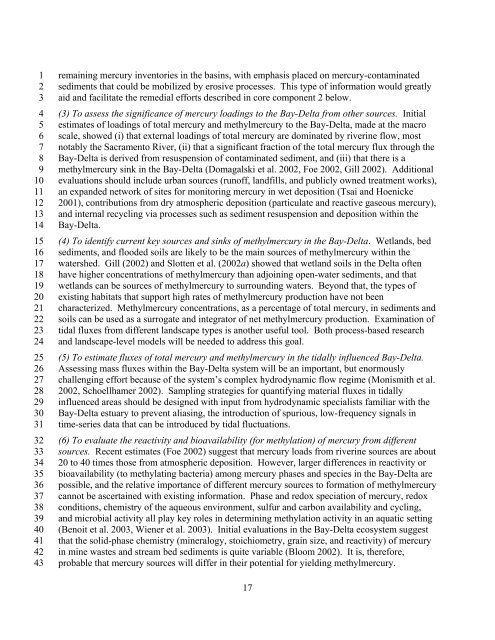Mercury Strategy for the Bay-Delta Ecosystem - CALFED Bay-Delta ...
Mercury Strategy for the Bay-Delta Ecosystem - CALFED Bay-Delta ...
Mercury Strategy for the Bay-Delta Ecosystem - CALFED Bay-Delta ...
You also want an ePaper? Increase the reach of your titles
YUMPU automatically turns print PDFs into web optimized ePapers that Google loves.
1<br />
2<br />
3<br />
4<br />
5<br />
6<br />
7<br />
8<br />
9<br />
10<br />
11<br />
12<br />
13<br />
14<br />
15<br />
16<br />
17<br />
18<br />
19<br />
20<br />
21<br />
22<br />
23<br />
24<br />
25<br />
26<br />
27<br />
28<br />
29<br />
30<br />
31<br />
32<br />
33<br />
34<br />
35<br />
36<br />
37<br />
38<br />
39<br />
40<br />
41<br />
42<br />
43<br />
remaining mercury inventories in <strong>the</strong> basins, with emphasis placed on mercury-contaminated<br />
sediments that could be mobilized by erosive processes. This type of in<strong>for</strong>mation would greatly<br />
aid and facilitate <strong>the</strong> remedial ef<strong>for</strong>ts described in core component 2 below.<br />
(3) To assess <strong>the</strong> significance of mercury loadings to <strong>the</strong> <strong>Bay</strong>-<strong>Delta</strong> from o<strong>the</strong>r sources. Initial<br />
estimates of loadings of total mercury and methylmercury to <strong>the</strong> <strong>Bay</strong>-<strong>Delta</strong>, made at <strong>the</strong> macro<br />
scale, showed (i) that external loadings of total mercury are dominated by riverine flow, most<br />
notably <strong>the</strong> Sacramento River, (ii) that a significant fraction of <strong>the</strong> total mercury flux through <strong>the</strong><br />
<strong>Bay</strong>-<strong>Delta</strong> is derived from resuspension of contaminated sediment, and (iii) that <strong>the</strong>re is a<br />
methylmercury sink in <strong>the</strong> <strong>Bay</strong>-<strong>Delta</strong> (Domagalski et al. 2002, Foe 2002, Gill 2002). Additional<br />
evaluations should include urban sources (runoff, landfills, and publicly owned treatment works),<br />
an expanded network of sites <strong>for</strong> monitoring mercury in wet deposition (Tsai and Hoenicke<br />
2001), contributions from dry atmospheric deposition (particulate and reactive gaseous mercury),<br />
and internal recycling via processes such as sediment resuspension and deposition within <strong>the</strong><br />
<strong>Bay</strong>-<strong>Delta</strong>.<br />
(4) To identify current key sources and sinks of methylmercury in <strong>the</strong> <strong>Bay</strong>-<strong>Delta</strong>. Wetlands, bed<br />
sediments, and flooded soils are likely to be <strong>the</strong> main sources of methylmercury within <strong>the</strong><br />
watershed. Gill (2002) and Slotten et al. (2002a) showed that wetland soils in <strong>the</strong> <strong>Delta</strong> often<br />
have higher concentrations of methylmercury than adjoining open-water sediments, and that<br />
wetlands can be sources of methylmercury to surrounding waters. Beyond that, <strong>the</strong> types of<br />
existing habitats that support high rates of methylmercury production have not been<br />
characterized. Methylmercury concentrations, as a percentage of total mercury, in sediments and<br />
soils can be used as a surrogate and integrator of net methylmercury production. Examination of<br />
tidal fluxes from different landscape types is ano<strong>the</strong>r useful tool. Both process-based research<br />
and landscape-level models will be needed to address this goal.<br />
(5) To estimate fluxes of total mercury and methylmercury in <strong>the</strong> tidally influenced <strong>Bay</strong>-<strong>Delta</strong>.<br />
Assessing mass fluxes within <strong>the</strong> <strong>Bay</strong>-<strong>Delta</strong> system will be an important, but enormously<br />
challenging ef<strong>for</strong>t because of <strong>the</strong> system’s complex hydrodynamic flow regime (Monismith et al.<br />
2002, Schoellhamer 2002). Sampling strategies <strong>for</strong> quantifying material fluxes in tidally<br />
influenced areas should be designed with input from hydrodynamic specialists familiar with <strong>the</strong><br />
<strong>Bay</strong>-<strong>Delta</strong> estuary to prevent aliasing, <strong>the</strong> introduction of spurious, low-frequency signals in<br />
time-series data that can be introduced by tidal fluctuations.<br />
(6) To evaluate <strong>the</strong> reactivity and bioavailability (<strong>for</strong> methylation) of mercury from different<br />
sources. Recent estimates (Foe 2002) suggest that mercury loads from riverine sources are about<br />
20 to 40 times those from atmospheric deposition. However, larger differences in reactivity or<br />
bioavailability (to methylating bacteria) among mercury phases and species in <strong>the</strong> <strong>Bay</strong>-<strong>Delta</strong> are<br />
possible, and <strong>the</strong> relative importance of different mercury sources to <strong>for</strong>mation of methylmercury<br />
cannot be ascertained with existing in<strong>for</strong>mation. Phase and redox speciation of mercury, redox<br />
conditions, chemistry of <strong>the</strong> aqueous environment, sulfur and carbon availability and cycling,<br />
and microbial activity all play key roles in determining methylation activity in an aquatic setting<br />
(Benoit et al. 2003, Wiener et al. 2003). Initial evaluations in <strong>the</strong> <strong>Bay</strong>-<strong>Delta</strong> ecosystem suggest<br />
that <strong>the</strong> solid-phase chemistry (mineralogy, stoichiometry, grain size, and reactivity) of mercury<br />
in mine wastes and stream bed sediments is quite variable (Bloom 2002). It is, <strong>the</strong>re<strong>for</strong>e,<br />
probable that mercury sources will differ in <strong>the</strong>ir potential <strong>for</strong> yielding methylmercury.<br />
17

















